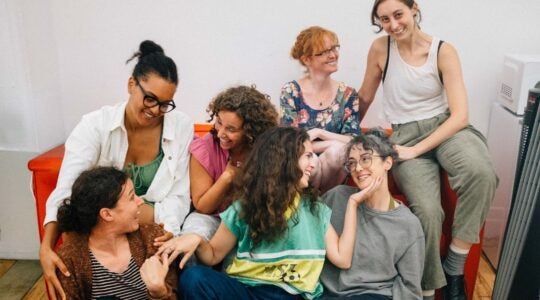Eyes peeled to a display terminal and wearing headphones, Shmuel Sherman looks like he is enjoying a video game or surfing the Net during a recent late-period class at Yeshivah Derech HaTorah in Brooklyn.
But Shmuel and the rest of his sixth-grade class at the Midwood yeshiva are engaged in an intensive and personalized reading experience.
“I was reading a story about Nellie Bly,” the 11-year-old reports as he logs off.
There may be no game, but there is a score, and Shmuel records it on a log sheet next to his computer, to the satisfaction of his reading teacher, Elissa Berkowitz, and the computer site manager, Mindy Levit.
“What we’re looking for is a score between 65 and 85 percent,” says Levit, referring to the percentage of correct answers.
The NCS computer software used by Shmuel and his classmates for reading and math is among the most advanced systems available, and Derech HaTorah is one of 15 area schools to receive it free in a pilot program of the Caroline and Joseph Gruss Life Monument Fund.
At a cost of $2 million, the fund has purchased and installed the computers, furniture and software. The schools are responsible only for providing a room and a lab manager.
The computers are being used by fourth- through seventh-graders at a diverse range of institutions, mostly in Brooklyn. They include the Conservative Harry Halpern Day School in Brooklyn, Modern Orthodox yeshivas like the Yeshivah of Flatbush and Hebrew Academy of Nassau County, and ultra-Orthodox schools such as Torah Vodath in Brooklyn and Yeshiva Yesode Hatorah, a chasidic girls school in Borough Park.
Some 3,000 students will benefit from the program this year, spending 40 minutes per week in math and 90 minutes per week in reading on the Gruss-funded computers.
“We want all our children to be able to compete in the marketplace of the 21st century,” says Gruss Fund president Jason Curry. “We really ran the gamut in the Jewish world in terms of hitting every community to make a positive statement about the importance of general studies. We hope the kids will succeed in using this technology.”
Next year, Gruss again will pay $2 million to implement the program at another 15 schools as part of the fund’s goal to keep Jewish education on par with other programs.
“Our vision is a vision of excellence in Jewish education, be it secular or nonsecular,” says Martin Gruss, board chairman of the fund named for his parents. “If Jewish schools are not giving as good an education as kids could get in public, private or parochial schools, we’re going to be turning out disadvantaged children whose future is not going to be as bright.”
Yeshiva principals note that the computer system allows each child, by entering a password at the start of a session, to learn at his or her own pace. The computer “remembers” each student’s strengths and weaknesses and offers questions accordingly.
With a few clicks of the mouse, Levit, the site manager at Derech HaTorah, prints out a detailed progress report for the entire class.
“The more advanced can go much quicker,” she says. “They are not held back by someone slower, and the kids who need more help don’t have to be embarrassed if they can’t keep up.”
The students find it “much cooler” to learn by computer than by what Berkowitz calls “chalk and talk” in the conventional classroom.
“It’s definitely a motivator,” she says. “This class has gone up a lot since they started doing this.”
Math or English teachers aren’t off duty while their charges are logged on. “I’m just as active [in the computer lab],” says Derech HaTorah math teacher Doreen Hacker, who circles the room offering assistance. “The kids get more individual attention.”
Yehuda Goldstein, the general studies principal at Derech HaTorah, says it’s too soon to gauge the impact of the program, and it has not been without its first-year kinks. Among the problems he noted are computer glitches and teachers who see the program as a hindrance rather than an enhancement.
“But in time, virtually all the teachers have come to see the benefits that self-pacing, individual progress provides for their students,” Goldstein says. “We’re looking forward to utilizing this project as a revolution for yeshiva education.”
Many of the yeshivas have used computers before for technology instruction, not for assistance in general studies learning.
“We had a regular computer lab in the building, but it is not for computer-assisted instruction,” says Isaac Fink, general studies principal at Yeshiva Torah Vodath. “The children are motivated, they are taking an interest, and making very nice progress. It gives the teacher another instrument to monitor their progress in reading and math.”
The Gruss Foundation distributes about $15 million in funds each school year. In addition to the computers, it also provides yeshiva and day school teachers with benefit programs, such as life insurance, a program recently availed by the family of Shoshana Greenbaum, a Hebrew Academy of Long Beach educator killed in the Sbarro pizzeria bombing in Jerusalem in August.
Curry says the fund hopes to use the successful computer program as a building block.
“The next step is to enhance the classroom curriculum,” he says. “We’ve been getting questions from administrators and teachers about how can we best utilize and integrate what we learn in the [computer] lab into the classroom. That’s something we’ll be looking into for next year.”
The New York Jewish Week brings you the stories behind the headlines, keeping you connected to Jewish life in New York. Help sustain the reporting you trust by donating today.




